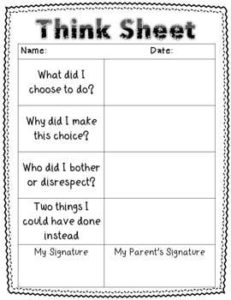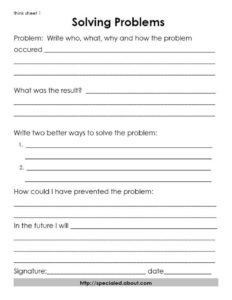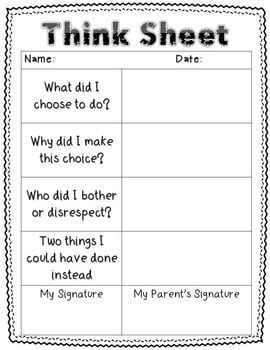Student Contributor: K. Shaqhan
 This tool is a sheet of paper with multiple questions on it about the misbehavior that occurred. Often students get disciplined and don’t know what they did wrong; this sheet allows them to reflect on what they did wrong and what they learned from their misbehavior.
This tool is a sheet of paper with multiple questions on it about the misbehavior that occurred. Often students get disciplined and don’t know what they did wrong; this sheet allows them to reflect on what they did wrong and what they learned from their misbehavior.
This is a last resort for the teacher to now correct the misbehavior that is present. The teacher will pull the student aside immediately during/ after the misbehavior has occurred to talk with the student one-on-one. At this point the teacher should have determined that the misbehavior is significant to the disruption of the classroom and needs to be stopped immediately. The teacher can choose where she/ he wants the student to fill the form out (ex: in the corner of the classroom, in the hallway, etc). Also the teacher can choose what they want to be on this form (ex: What was the misbehavior? Why was it wrong? Why did you do it? What could you have done instead?). If the behavior is so significant that the teacher feels the parents need to know about it then this can be a form that is sent home with the student and requires the student to return it the next day with their parent or guardian’s signature.
 This tool belongs in the Corrective Phase because it is to be used after the teacher has already tried supporting the child and giving them the tools they need to stop the misbehavior but it hasn't stopped. At this point the teacher must take corrective actions in trying to eliminate the misbehavior.
This tool belongs in the Corrective Phase because it is to be used after the teacher has already tried supporting the child and giving them the tools they need to stop the misbehavior but it hasn't stopped. At this point the teacher must take corrective actions in trying to eliminate the misbehavior.
This tool belongs in all of the categories of the Theories of Influence because the teacher needs to intervene with the student and the misbehavior (Teacher-Directed), have a one-on-one talk with the student (Collaborative), then the student needs to fill out the form and reflect on what they did wrong (Student-Directed).
More Information –
Tool Source: PBIS World
https://bit.ly/2E2Eqaz


